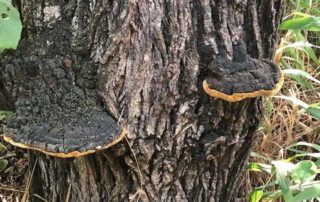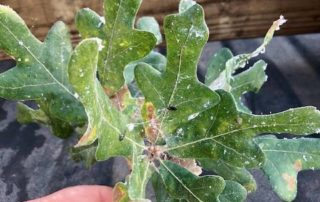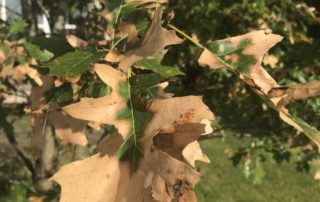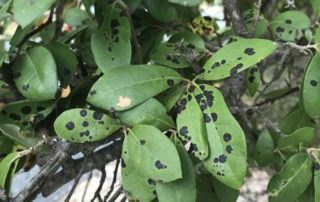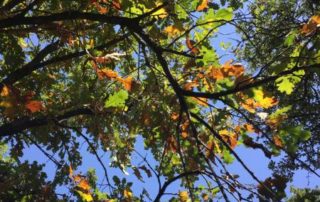Our Tree Care Services Pflugerville, TX
At Good Guys Tree Service we care deeply about the long-term health of your trees. We have over 20 years industry experience, with our team of passionate arborists here to help with all your tree service needs in Pflugerville, Texas.
Services We Provide As Tree Doctors Who Care
- Chlorosis & Other Mineral Deficiencies
- Fungal Infections
- Conks, Cankers, Brackets & Armillaria growths
- Wound Care
- Bacterial Infections
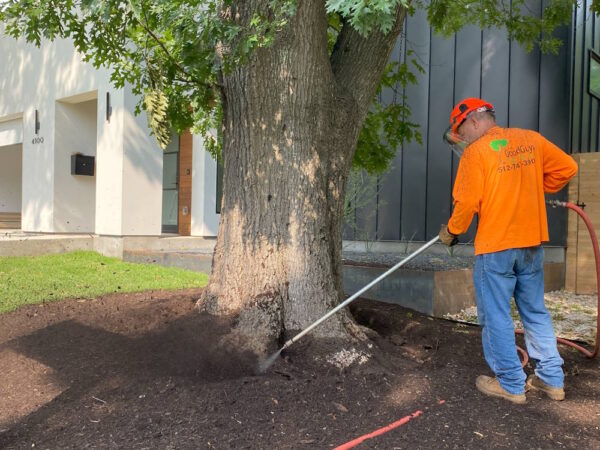
Chlorosis – A Common Issue Affecting Trees Throughout Pflugerville
Just like us people, trees need the right balance of minerals and nutrients to remain fit and healthy. Here in Pflugerville, the climate poses some unique challenges for trees, with many trees suffering from mineral deficiencies that are hampering its long-term health.
The Problem
Chlorosis, a type of iron deficiency, is perhaps the most common mineral deficiency impacting trees in Pflugerville. You can identify by checking the leaves on the tree, which will look lighter green or even yellow rather than a rich, dark green color.
Other types of mineral deficiency common in the area include manganese and zinc, which result in blotchy and underdeveloped leaves.
The Solution
The best treatment for chlorosis and other mineral deficiencies is the use of special injections. These have a special formula that helps the tree better absorb minerals like iron into their vascular system.
This process shows results in as quickly as four weeks, with leaves becoming healthier and more vibrant in no time. Should this not get the results we were hoping for, we may suggest a soil treatment to restore the nutrient and pH levels, encouraging healthier root development and better mineral absorption.
Good Guys Tree Service provides certified arborist consultations, full treatment programs and complete tree maintenance services. Contact us today to schedule an appointment!
Fungal & Bacterial Infections That Truly Need a Tree Doctor
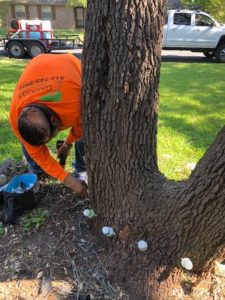 There are dozens of different fungal and bacterial infections that impact trees in Pflugerville, making it challenging to identify the problem before it is too late. Here at Good Guys Tree Service we can easily identify all common fungal and bacterial infections effecting trees and provide necessary solutions.
There are dozens of different fungal and bacterial infections that impact trees in Pflugerville, making it challenging to identify the problem before it is too late. Here at Good Guys Tree Service we can easily identify all common fungal and bacterial infections effecting trees and provide necessary solutions.
The Problem – Fungal Infections
Fungal infections are a big issue for trees, causing leaves to look spotted, streaked, warped, or covered in mold. Twigs may also show signs of dying, especially towards the tips, so they generally make the tree look terrible and much weaker.
The Solution
The good news is that we can easily treat tree infections in Pflugerville by using a systemic fungicide. Applied via a spray or injection, this treatment eliminates the fungal infection and control its future spread. Some pruning may also be required depending on the extent of the infection.
The Problem – Bacterial Infections
Bacterial infections are usually found on fruiting trees, with common signs of an infection including blight, scorching, shriveling, or burnt tips on leaves. Also, if the tree has an open wound there is usually a black residue coming from it when there is an infection.
Root rot is also a sign there is a bacterial infection, although this is harder to spot as the roots are not visible – we can complete a root analysis to determine if the roots are infected
The Solution
Different solutions are implemented based on the cause of the infection. For instance, if the cause of the infection is root rot then we will improve the tree’s drainage system to address the issue, while insect-related infections are usually treated with an insecticide.
Many infections can be stopped by pruning the canopy, which often causes the spread when there is too short a distance between trees. Airflow and high moisture can also exasperate infections in closely planted trees.
In any case, we need to analyze the individual trees to determine the cause of the infection, taking appropriate action after this. We may recommend a treatment to encourage recovery after the infection is stopped – get in touch for options about possible treatment solutions!
Tree Growths Like Conks, Cankers, Brackets, and Armillaria
Many trees throughout Pflugerville have unsightly growths like conks, cankers, brackets, and armillaria. While these are technically a type of fungi, they pose a different challenge for arborists compared to other easily treatable fungal infections.
The Problem – Growths on the Tree Trunk
Growths at the base or the side of the tree trunk are a major problem that may not have a suitable solution. Sadly, when found here the growth indicates that the fungus is being fed by dead wood inside the bark, meaning it is only a matter of time before it spreads and kills the entire tree.
The Solution
While you can slow the spread when growths are present on the upper portion of the tree, most that have a growth on the main trunk are going to eventually become too unstable and risk falling over. In these cases, the only solution is to remove the tree.
Contact us for a proper evaluation of your tree growth to determine the severity of the problem and whether there are possible solutions!
Tree Wound Care
All trees are likely to suffer wounds at some point. Nature throws all the elements it has at our trees, while things like human activities can result in various wounds to the trees throughout Pflugerville. Thankfully, we can offer treatments for damaged and wounded trees!
The Problem – Trees Wounds Impacting Long-term Tree Health and Causing Possible Safety Risks
Any sort of damage to the tree may cause a problem down the line, such as making it more susceptible to infections to posing a safety risk to your family members due to falling branches. A damaged tree is not just about improving aesthetics!
The Solution
Thankfully, we do not need to do much when dealing with tree wounds. Our trees are amazingly resilient, capable of regrowing and repairing large parts of themselves without any intervention. We don’t even cover the wounds as an open wound heals much quicker on a tree.
In some extreme cases we may offer a special treatment that helps the tree to recover better from the damage, although this is rarely needed as trees do most of the work themselves!
Insect Infestation
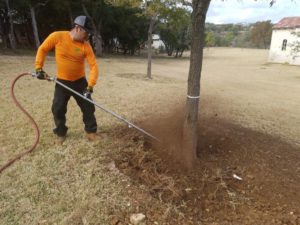 Trees provide home and food for all kinds of wildlife, with countless insects found on your average tree in Pflugerville. These are usually no issue as they play an important role in the ecosystem, although there are instances where you may need help from one of our tree surgeons.
Trees provide home and food for all kinds of wildlife, with countless insects found on your average tree in Pflugerville. These are usually no issue as they play an important role in the ecosystem, although there are instances where you may need help from one of our tree surgeons.
The Problem – Leaves, Wood, and Roots Infected by Insects
Various parts of the tree can be infected by insects. Leaves are the most common, providing natural sustenance for various insects. They are not a problem in most cases, although too many insects may cause a higher percentage of foliage loss – anywhere between 10-15% is considered a problem.
For the bark and branches, signs of sawdust or woodpecker holes are a problem. This indicates wood burrowing larva inside of the tree, which cause major issues down the line by eating away large portions of the tree!
Finally, root systems may be infected by unwanted insects, causing slower root development, which in turn inhibits tree growth.
The Solution
Each solution is easy enough to treat with an appropriate insecticide. We will need to evaluate the problem to identify what type of insect is causing the problem, after which we use the necessary product to kill them off, usually via injection or soil drench.
Soil Compaction
Soil compaction effects a lot of trees around Pflugerville. The challenge is knowing when soil compaction is present, as it can be hard to spot the obvious signs because the soil is below the ground!
We can help identify when soil compaction is impairing tree health and provide easy solutions to the problem.
The Problem – Soil Compaction Impairing Root Development
There are many causes to soil compaction, most related to high foot traffic/impact around the area at the base of the tree. When this occurs, soil becomes too compacted to provide effective airflow and drainage, making it harder for the tree to get the necessary moisture, air, and nutrients to thrive.
The Solution
- We take a two-pronged approach to treating soil compaction. The first stage involves a process called vertical mulching where we dig several holes in a grid pattern around the base of the tree using an auger.
- Once drilled to the require depth and width, the holes allow more air, nutrients, and water to reach the entire root system, encouraging healthier root growth and in turn a healthier tree. We fill all holes with gravel and compost to ensure they don’t immediately compact again, improving drainage over the long-term.
- The second treatment involves creating a mulch bed at the base of the tree. This helps avoid future, although you may require a fencing option if the tree is in a public area like a park or playground.



